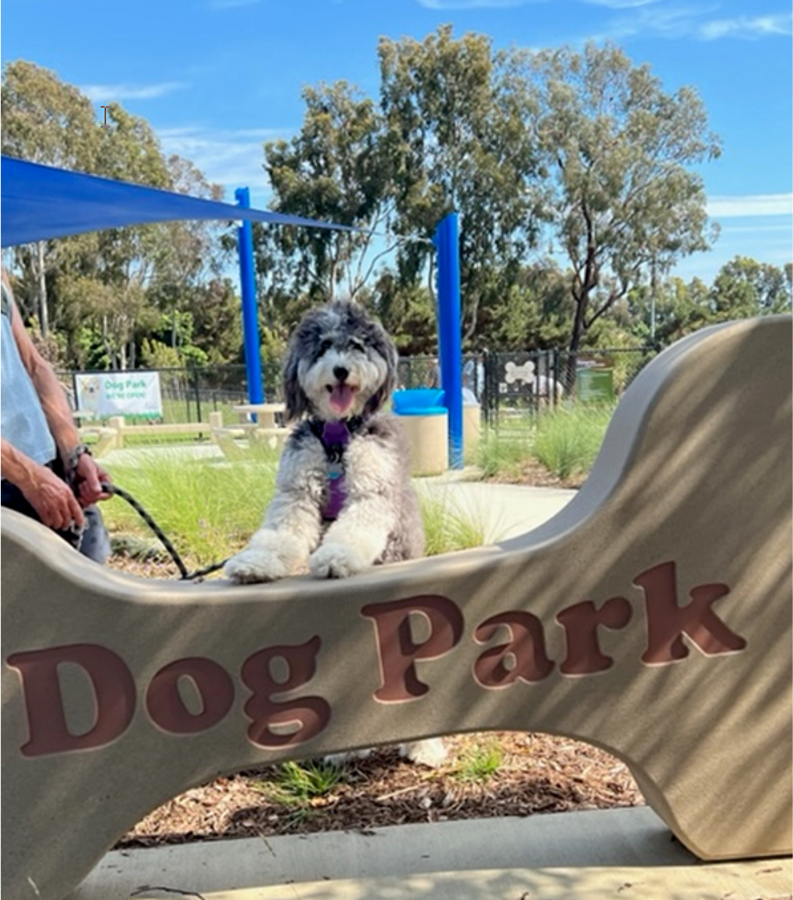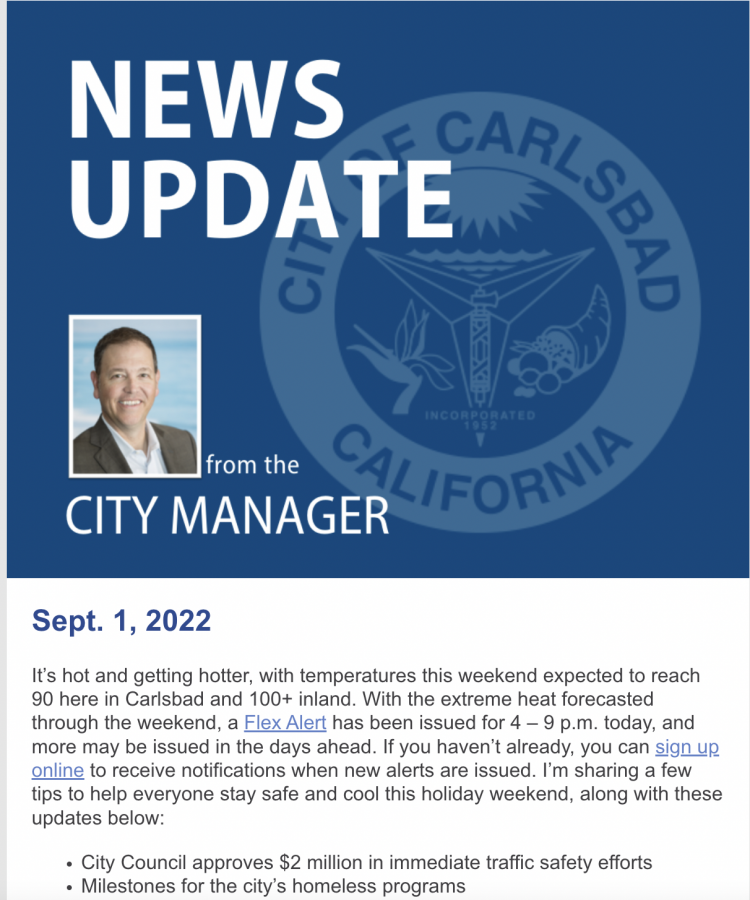Don’t delete the human: Five ways to humanize your high-tech communication
Kristina Ray is the director of communication and engagement for the city of Carlsbad. She can be reached at kristina.ray@carlsbadca.gov.
Just a few weeks ago, a Carlsbad resident sent us a picture of their dog. “Residents sending in pictures of their dogs” is not an official performance metric for the city of Carlsbad’s communication department. But it’s a perfect example of what the city has begun to measure: evidence of a positive, respectful relationship between the city organization and the community it serves.
“[Your] weekly updates … keep us all in the loop,” wrote Bonnie M. “We (have) now visited the Dog Park @ Poinsettia Park twice! What a magnificent job Carlsbad has done. Poinsettia looks great as well. All the hard work is so appreciated. I have attached Skye’s pix as she left the park today.”
Scott Chadwick, the city manager, didn’t get the note just because the dog park is amazing. He got the note because of the city’s ongoing commitment to an open, clear, and deeply human digital communications strategy. Thanks to this commitment, the newsletter subscribers list has grown by a third and its open rate has rocketed to 65%, several times higher than the national average.
Relatable communication builds trust
Government communication, some will argue, is an oxymoron. To be fair, government deals with complex issues, is often expected to be all things to all people, and operates in an environment with little tolerance for risk. This is not a set of circumstances that leads to open, trusting communication.
As a result, public agencies tend to err on the side of caution, putting out information that is long, technical, and very formal. People don’t want to read it and if they do, they probably don’t fully understand it. This reinforces the perception of government as out of touch and lacking transparency. This negative filter then colors everything people see coming from government.
On the other hand, when government sees the end goal of communication as relationship-building rather than information-sharing, an opportunity opens up for a different style of interaction — one that feels more like a two-way conversation.
“No one likes to be talked at,” Chadwick noted. “People want to feel a sense of connection; it’s how we’re wired.”
Making the business case for a dog park picture metric
A business case can be made for this relationship-focused approach. When people trust you, they give you the benefit of the doubt when things get tough. They forgive you when you make an occasional mistake. They may even support you despite disagreeing with what you’re doing. This can result in:
- Getting projects done on time and within budget because residents aren’t suspicious of your every move.
- Making operations more efficient and effective because you’re provided a way to get feedback from the people you serve on an ongoing basis, not just when problems are big.
- Saving time by minimizing rumors and misinformation in the community.
- Better employee morale due to community appreciation and acknowledgment.
Here in Carlsbad, the results speak for themselves. Like all cities, Carlsbad (population 115,302) found itself in a rapidly changing environment full of uncertainty during the early months of the COVID-19 pandemic. One of Chadwick’s first directives was to issue a daily update to the community, and he wanted it to come from the city manager.
Some of us were hesitant. The city’s newsletter had a 40% open rate — about twice the national average. But we decided to take the leap. The format and overall look didn’t change from its previous iteration, just the tone. Written in the first person from the city manager’s perspective, Chadwick’s new newsletter conveyed empathy and emotion at a time when the community needed it the most.
Readers responded in droves with everything from a simple thank you to an in-depth critique of the city’s COVID-19 response. Either way, city staff responded personally, often mentioning these comments, good and bad, in the next issue. The newsletter began to feel like a two-way conversation with the community. Staff also started to see an uptick in subscribers and open rates.
As the pandemic faded into the background, city staff broadened the newsletter to other topics but kept the personal tone. Chadwick often highlighted specific employees when mentioning projects, explaining what they do and why they love public service. Bit by bit, he painted a picture of government that didn’t look like an institution; it looked like people.
When the newsletter went back to its once-a-week cadence, staff expected a drop off in subscribers and open rates. Instead, open rates crept up another five percentage points and the list continued to grow, largely by word of mouth.
“We have been able to build trust with the public because we communicate regularly, in plain English, and that creates transparency,” Chadwick said. “But the real game changer has been allowing them to see the human beings within their local government as people, just like them. That’s a strong foundation to build from.”
Looking at back issues, five things jump out as contributing to the human touch. And all five are easily replicable by other agencies — as long as they are willing to put themselves out of their comfort zones just a little.
Step 1: Put a face on it
The first step to communicating like a human is to identify a human who can be the face of what you’re putting out to the public. This is easier said than done. Each agency is different when it comes to who typically serves as a spokesperson.
Some have a communication staff person who can be that face. In our case, we use the city manager because the topics in the newsletter are related to day-to-day city operations across all departments, rather than policy issues, which could be better coming from an elected official.
However, we also include updates on council meetings and decisions on every issue. We encourage the public to get involved through city council meetings and by sharing their feedback with their elected officials. This way, the newsletter is never seen as promoting a political point of view. Instead, it informs people about what their elected officials are doing for them and encourages civic engagement.
“I’d much rather be criticized for over-communicating or being too casual in my tone than reinforcing a bad stereotype some people have of government as bureaucratic,” Chadwick, said. “How we communicate can make or break what people think of their local government.”
What about staff turnover? It’s true: People come and go. Even though it is not ideal to start over with a new face for your communications, it is still worthwhile in the long run. Plus, introducing someone new to the community can provide an opportunity to take a fresh look at how you are communicating and make any needed refinements.
Depending on the agency, your department or division might communicate directly with the public. This is also an opportunity to create a personal connection. Even if it means simply ending a community update with the director’s name and signature, small personal touches end up creating that feeling of connection over time.
Step 2: Use plain language
Once you have a person who will be the face of your agency, be sure that the tone of your communication also has a personal touch. Use relatable stories and anecdotes to help people understand city projects and initiatives.
Most importantly, use the same words that you use when talking to your neighbors or close friends. Jargon, abbreviations, and acronyms are the quickest way to alienate your audience. This can be a tough habit to break, but it’s well worth the effort. Your readers will appreciate it.
“You presented the hard facts, but always with gentl[e] reminders that each person’s individual behavior can/will have a positive impact on limiting the spread of COVID,” Carlsbad resident Evelyn T. wrote in July 2021. “Your writing style has a friendly tone, like that of a caring neighbor, who just happens to be the city manager.”
Step 3: Show (appropriate) emotion
One advantage of using a human-centered approach in the early months of the pandemic was that it provided opportunities to display appropriate emotion. This raises an obvious question: “What is appropriate?” That will depend on the personality of your agency, but empathy is a great place to start.
For example, if you’re sharing information about a construction project, it’s okay to acknowledge the frustration of sitting in traffic. Everyone already knows construction can cause traffic delays. Acknowledging that puts your agency on the same side as your residents.
A sincere thank you goes a long way. Instead of the generic “thanks for your patience,” try something like this: “Hey, let’s face it, driving through a road construction area can be frustrating. I want to really thank you for all your patience and understanding as we work to get this done as quickly as we can.”
Emotion can be a part of far less serious topics too. If you are in a heat wave, it’s okay to mention how much you’re looking forward to returning to a favorite outdoor activity once things cool down. You are still a government agency, so the range of appropriate emotions may be narrower than in other organizations. But if you look, I bet you will find something human to acknowledge in every issue.
Step 4: Be responsive
If you are lucky enough to prompt a reader to contact you, use that golden opportunity to strengthen your agency’s relationship with them. Even a brief response is often met with a pleasant surprise, which creates a lasting impression.
Keep in mind that this doesn’t have to be an all-or-nothing approach. Staff can pre-write responses to common questions and comments and get those turned around quickly. A frequent critic may need to get a “let’s agree to disagree” message or be referred to the public records department for additional information. But by and large, any personal response from a government agency is typically seen as a pleasant surprise that residents remember.
Step 5: Earn trust
During an emergency, opportunities to build trust come daily. During regular operations, you often need to seek them out. Most agencies will eventually put out incorrect information by mistake. This is a very low-risk opportunity to own the mistake, put out the correction, and apologize. Carlsbad’s newsletter even fesses up to typos.
Whenever staff acknowledge a mistake, community members often reach out just to say, “no big deal” or “thanks for taking responsibility.”
Of course, some mistakes may be more significant, and saying you’re sorry can expose your agency to potential litigation. Even in these cases, artfully acknowledging the situation and explaining why you cannot share details still demonstrates a commitment to transparency.
Three simple goals to get you started
Here is the best part about humanizing your high-tech communications. You don’t need to transform the way you communicate overnight. In fact, doing that could come across as inauthentic.
Instead, dip your toe in the water by having a friend outside of government read the communication you develop and give you an honest review. Is it clear? Is it easy to understand? Is it friendly? Those are three great goals to get you started. Stay the course and your community will start to see their local government more like a trusted friend they want to grow old with.
“I am so impressed with this update every time it comes out,” said Tim E. in response to a recent newsletter. “Very informative, written very well and makes you realize what a great city we live in. Cheers to everyone involved for putting this update together.”






